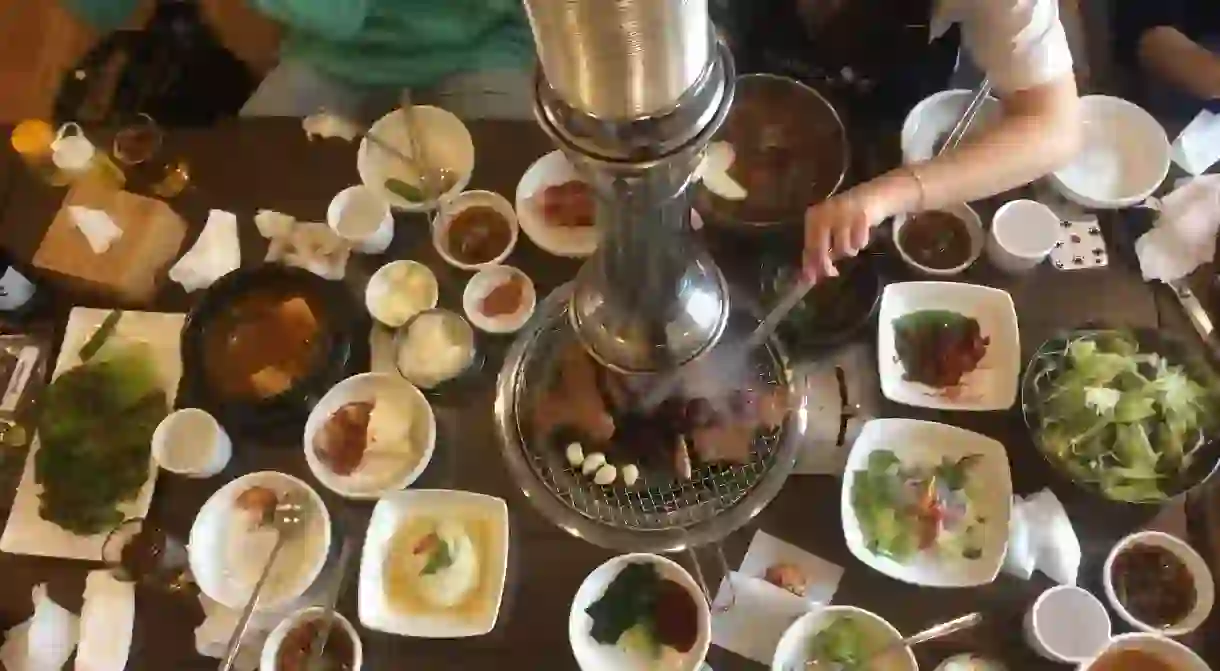13 Non-Spicy South Korean Dishes Worth Trying

Like most of its Asian neighbors, South Korea’s got a reputation for producing great spicy food. And rightfully so—Koreans barely bat an eye at a Cheong-gochu chili pepper or fiery ramen noodles. But for those less tolerant souls, don’t fret, there are plenty of Korean delicacies that don’t pack a punch. Here are 13 non-spicy dishes, sparing you those tear-filled eyes.
Bulgogi
Bulgogi is one of Korea’s signature dishes, having become popular worldwide for its sweet marinade of soy sauce, sesame oil, sugar and ginger. It’s often served up with lettuce, side dishes and dipping sauces to make wraps. After you’ve enjoyed all the meat, pour the remaining broth over some rice and let it soak up all that delicious flavor.

Donkatsu
If you’ve ever had chicken fried steak and liked it, you’ll love this. A large slab of pork is fried up and served on a plate with rice, miso soup, a small salad and a sweet barbecue sauce. Most corner restaurants have this signature dish priced as cheaply as 6,000 won (US$5) a plate.

Kimbap
This sushi-like roll comes in all sorts of varieties, including tuna fish, kimchi, fish cake or veggie. No matter which one you go for, rolled up in the rice and seaweed you’ll always find cucumber, spam, pickled radish, egg, spinach and carrots. No spice—all good.

Japchae
These beloved noodles, nicknamed “glass noodles” due to their subtle transparency, are made from sweet potatoes. Usually served up as a side dish in larger meals, Japchae noodles are stir-fried in sesame oil and seasoned with sugar and soy sauce. While some versions are vegetarian, you’ll most likely find some strips of beef tossed in.

Pajeon
While scallions are the main ingredient of this traditional Korean pancake, egg batter, wheat flour and rice flour are imperative for its signature fluff. Though similar to a Chinese scallion pancake, pajeon is made with batter instead of dough. Beef, pork, shellfish and kimchi are among the most common flavors.

Seolleongtang
This ox bone stew is left to simmer for at least 14 hours, giving it the richness that makes it a hearty winter staple. Seasoning is done depending on preferences, so no worries on spice with this one—you can stick to simple salt and pepper!

Jjajangmyun
Jjajangmyun is the ultimate Chinese-Korean fusion dish. Don’t let the dark black bean sauce sauce put you off, because these thick noodles with diced veggies and pork are a must-try. It’s mild flavor is perfect for those with a low spice tolerance, but if you’re feeling adventurous, try it with a little extra kick.

Korean fried chicken
South Koreans know how to do their chicken. It’s fried twice and comes out lighter and crispier than its American counterpart. Korean Fried Chicken (KFC), simply known as chikin, encompasses a number of different spice levels and varieties. Some like huraideu chikin, are safe for those who don’t like spicy food.

Hotteok
Hotteok is a popular treat found in street-food markets and stalls. It consists of a dough pancake stuffed with sugar and cinnamon, fried to perfection in front of your eyes. Usually cooked up by sweet ajummas, or middle-aged women, these make for the perfect snack on your walk home from work.

Odeng
These long strips of fish are quite enjoyable and are another popular type of street food. Boiled in a light miso soup, odeng is usually dripping with flavor. Enjoy this fishcake-like dish at Korean food stands or try eomuk bokkeum, the stir-fried version found at any Korean barbecue joint.

Gyeranjjim
Often served as a side dish, this steamed egg and water dish makes for the perfect light lunch. Sometimes cooked up with green onion, salt and pepper, even Koreans will use this to counteract the sometimes over-the-top spice levels!

Naengmyeon
These thin buckwheat noodles, often dished up cold, are perfect for combating the heat during summer months. They’re usually topped with eggs, meats and veggies, and served in a refreshing vinegar-based broth.

Samgyeopsal/Galbi
Traditional Korean barbecue meals involves cooking up the raw meat yourself on small, table-top grills. While some of the traditional side dishes in this type of dining pack some punch, the main meats aren’t spicy. Samgyupsal— unseasoned pork belly, doesn’t have much flavor at all. Dip it in the yellow sesame oil, salt and pepper sauce for a nice boost in taste. Make sure to save room for the king of all Korean meats: galbi beef. It’s a little pricier, but once you start enjoying the sweet marinade and premiere cuts, you’ll really notice the difference.














